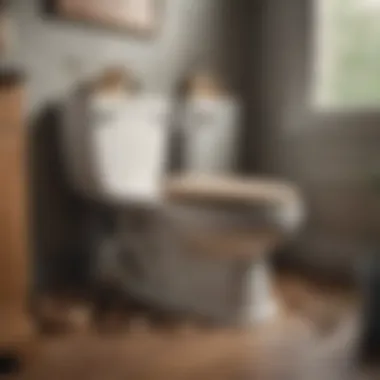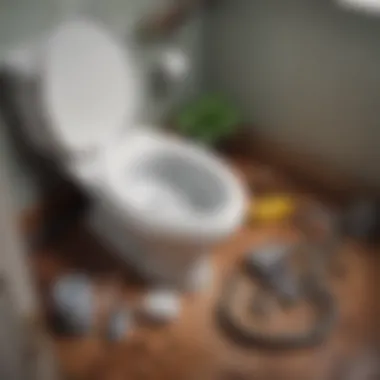Effective Solutions for Snake Toilet Clogs


Intro
Toilets are crucial components in our homes, serving both functional and aesthetic purposes. However, the issue of snake toilet clogs is often overlooked until it becomes a major problem. Understanding this phenomenon is essential for homeowners who wish to maintain a comfortable living environment. This guide aims to unravel the complexities of snake toilet clogs, exploring their causes while providing effective prevention methods and solutions.
Snake toilet clogs occur when long, snake-like objects—often related to plumbing issues—block the proper flow of waste through toilets. By delving deeper, we can illuminate this subject, making it easier for anyone to navigate.
Understanding the Mechanics
A basic grasp of plumbing mechanics helps in identifying the roots of this issue. Toilets rely on gravity and water pressure to transport waste through an intricate piping system. Blockages disrupt this process and can lead to more severe plumbing issues if left untreated.
The Importance of Prevention
Prevention is often the most cost-effective approach. Regular maintenance can significantly reduce the risk of clogs. Homeowners need to be aware of what may inadvertently be sent down the toilet.
This article will prepare you to tackle snake toilet clogs intelligently by addressing essential topics, highlighting practical tools available for maintenance, and advocating for proactive measures. The synergy between a well-maintained plumbing system and a stylish bathroom is not just desirable; it is fundamental.
Prolusion to Toilet Clogs
Toilet clogs are a common but often frustrating occurrence in households. Understanding various aspects of toilet clogs is essential for every homeowner. This knowledge assists in diagnosing issues early, which can prevent costly repairs and inconvenient plumbing emergencies.
Identifying the signs of a clog helps to act promptly before the situation escalates. Frequent clogs can signal deeper plumbing issues. In many instances, an understanding of the core problems equips homeowners to maintain their plumbing efficiently.
Regular maintenance and a proactive stance can mitigate the risk of clogs. Homeowners who know what causes toilet clogs increase their ability to take preventive measures. Sound knowledge allows for educated decision-making when faced with a clog situation.
Household members should be educated on what can and cannot be flushed to avoid unnecessary blockages. This collective understanding promotes a cooperative environment aimed at preserving plumbing installation.
Furthermore, investing in the right tools and equipment can prove invaluable. Knowing whether to use a snake tool or other methods can determine the efficiency of resolving a clog. By grasping the essentials of toilet clogs, homeowners not only contribute to the functionality of their living spaces but also enhance the overall aesthetic of their bathrooms.
Understanding how to manage toilet clogs effectively is not just about maintenance; it’s about ensuring plumbing health and supporting a comfortable living environment.
In this section, we will explore the anatomy of toilet clogs, their causes, and the signs indicating a problem. This foundational knowledge serves as preparation for the subsequent sections detailing the mechanisms behind toilet plumbing and the best practices for preventing any future clogs.
Understanding Snake Toilet Clogs
Understanding snake toilet clogs is essential for any homeowner. Recognizing the intricacies of toilet plumbing can facilitate prevention and quicker resolutions when clogs occur. Snake toilet clogs typically arise from objects or build-up in pipes, often necessitating the use of a plumbing snake for effective removal. This article delves into the significance of understanding these clogs and their prevention.
What is a ‘Snake’?
A "snake" in plumbing refers to a flexible tool, usually made of metal or plastic, designed to navigate through pipes to clear blockages. There are various types of plumbing snakes, including handheld augers and motorized versions. Their primary purpose is to reach and dislodge debris that causes clogs, often situated deep within the plumbing system. Familiarity with this tool allows homeowners to perform minor repairs, avoiding the need for professional assistance in many cases.
Common Causes of Snake Toilet Clogs
Several factors can lead to snake toilet clogs. It’s important to identify these elements early to implement preventive measures:
- Foreign objects: Items like toys, feminine products, or excessive toilet paper often end up in toilets, leading to blockages.
- Build-up: Accumulation of debris over time can create a solid mass, making it difficult for waste to pass.
- Pipe design: Certain toilet models may not be as efficient in flushing waste, resulting in more clogs.
Being aware of these causes helps in maintaining a functional toilet system.
Identifying Signs of a Clog


Signs of a clog can vary, but recognizing them early can prevent bigger issues. Here are some common indicators:
- Slow flushing: Water takes longer than usual to drain.
- Gurgling sounds: Unusual noises from the toilet can indicate trapped air or water.
- Seepage: Water pooling around the base can suggest an underlying issue.
Awareness of these signs allows homeowners to act quickly, ensuring minor issues do not escalate into major plumbing problems.
The Mechanism of Toilet Plumbing
Understanding the mechanism behind toilet plumbing is crucial for addressing snake toilet clogs effectively. Toilets, although seemingly simple, operate on intricate mechanisms involving various components and fluid dynamics. A comprehensive knowledge of these systems allows homeowners to diagnose issues better and apply effective solutions for clogs, potentially saving money and avoiding unnecessary calls to professional plumbers.
Toilet Components Explained
To grasp how a toilet operates, it is vital to familiarize oneself with its main components. Each part has a specific function that contributes to the overall operation of the toilet. Here are the key components:
- Toilet Bowl: This is the visible part of the toilet where waste is collected. It is designed to hold water and has a trap that keeps waste from entering the plumbing system when the toilet is not in use.
- Toilet Tank: Located behind the bowl, the tank holds water for flushing. When the lever is pressed, a flapper valve opens, allowing water to flow from the tank into the bowl.
- Flapper Valve: This component regulates the flow of water from the tank to the bowl. If it fails to close properly, it can cause continuous running water, leading to potential clogs.
- Fill Valve: This automatic device refills the tank with water after a flush. Proper functionality here ensures enough water for effective flushing.
- Trapway: This is the curved pipe within the bowl that holds water and prevents odors from escaping. An obstruction here can lead to severe clogs.
By understanding these parts, homeowners can identify which component is malfunctioning when they experience a clog. This foundational knowledge reduces frustration and aids in more efficient troubleshooting.
Fluid Dynamics in Toilets
Fluid dynamics play a pivotal role in how toilets function and flush waste effectively. The science behind fluid movement is essential for understanding why clogs occur. When the toilet is flushed, gravity and the pressure of water create a swift movement of fluid. This action draws waste and additional water through the trapway and into the drain.
A few important factors influence fluid dynamics in toilets:
- Gravity: The toilet relies on gravity to move waste and water. A sudden change in gravity, for example, might create pressure differences, potentially leading to clogs.
- Water Volume: The amount of water used during a flush is crucial. If the flush doesn’t use enough water, waste may not fully clear the bowl, increasing the likelihood of clogs.
- Air Pressure: Changes in air pressure within the plumbing system can affect how the water moves. Blockages in the vent stack can cause negative pressure, which impacts flushing efficiency.
Understanding these dynamics is essential for homeowners. Regular monitoring and maintenance can help ensure their systems operate as intended, reducing the risk of future clogs.
The intricate relationship between the components of toilet plumbing and the principles of fluid dynamics provides valuable insight into how clogs can form and how to prevent them. Homeowners equipped with this understanding can make informed choices about maintenance and repairs.
Methods for Preventing Toilet Clogs
Effective prevention of toilet clogs is essential for maintaining a functional bathroom environment. Understanding the underlying causes and implementing practices aimed at prevention can greatly reduce the frequency and severity of clogs. This section will discuss the key practices, the importance of consistency in maintenance, and the need to educate all household members on proper usage.
Regular Maintenance Practices
Regular maintenance is a cornerstone in the prevention of toilet clogs. Small, consistent efforts can save homeowners significant time, effort, and money in the long run. Here are several maintenance practices to consider:
- Routine Inspection: Check for any leaks, unusual noises, or signs of corrosion in the toilet components. Early detection can prevent larger issues.
- Tank Cleaning: Periodically clean the tank and its components. This can prevent the buildup of mineral deposits that might impede water flow.
- Check Water Levels: Ensure that the water level in the tank is at the proper height. Incorrect levels can affect flushing efficiency.
- Use Toilet Cleaners Wisely: Avoid flushing harsh chemicals that can erode plumbing. Instead, use biodegradable cleaners that are less harmful.
These practices enhance the longevity of your toilet and contribute positively to plumbing health. Moreover, homeowners should set a maintenance schedule that allows for these checks to be conducted regularly.
Educating Household Members
Education plays a vital role in preventing toilet clogs, especially in households with children or guests. Ensuring that everyone understands proper toilet usage promotes good habits that directly influence plumbing health. Here are key points on how to educate:
- Explain What Can Be Flushed: Clearly inform household members about what materials can and cannot be flushed. Items such as wipes, feminine products, and paper towels should never be sent down the toilet.
- Encourage Responsible Use: Discussing the importance of using appropriate amounts of toilet paper can help reduce clogging cases.
- Demonstrate Proper Techniques: Show younger family members how to use the toilet properly. Sometimes, a simple demonstration can clarify things more than verbal instructions.
- Instill Awareness: Remind everyone to report potential issues, such as slow draining or unusual noises, immediately.


Educating household members fosters a collective responsibility towards maintaining plumbing integrity. With a well-informed household, the likelihood of encountering serious clogs decrease significantly.
Incorporating regular maintenance practices and encouraging educational measures can transform a household's approach to plumbing health. Together, they form the foundation for a clog-free toilet experience.
By prioritizing these methods, homeowners can create a more resilient plumbing system, ensuring functional and aesthetically pleasing bathrooms that serve their purpose without interruption.
Snake Tools: An Overview
Understanding snake tools is vital for effectively addressing snake toilet clogs. The right tools not only simplify the unclogging process but also minimize the risk of damage to the toilet. Knowing the various types of snakes and their applications helps homeowmers and DIY enthusiasts choose the best method for their specific clog. This section will expound on the different types of snakes available in the market, along with considerations for selecting the most suitable tools for unclogging toilets.
Different Types of Snakes
When it comes to snake tools, different designs cater to various clog situations. The main types include:
- Toilet augers: Specifically designed for toilet use, toilet augers have a protective sleeve to prevent scratching the porcelain. They typically feature a flexible cable that can navigate the toilet's trap.
- Handheld snakes: These are more versatile and can be used in various plumbing applications. They tend to be less expensive but may lack the power needed for tougher clogs.
- Power snakes: Powered by electricity, these snakes are robust. They work well for stubborn clogs deep in the plumbing system but require caution during use to prevent damage.
- Cabling machines: These heavy-duty machines are often used by professionals. They can effectively clear large blockages but may be impractical for average household use.
Choosing the appropriate type depends on the specific clog circumstances, as well as the user’s skill level.
Choosing the Right Tools
Selecting the right snake tool is an important step in resolving toilet clogs. When choosing, consider the following factors:
- Type of clog: Different clogs require different tools. Analyze what may have caused the blockage to determine your approach.
- Toilet style: Ensure that the snake is compatible with your toilet design. Some bowls may require specialized tools.
- Skill level: Assess your own experience with plumbing tools. If unsure, starting with simpler tools or consulting a professional may be prudent.
- Cost vs. utility: Weigh the price of the tool against how often you expect to use it. Investing in a high-quality auger may save money in the long run if toilet clogs persist.
Always select a tool that balances efficiency and safety to protect your plumbing and maintain functionality.
Being informed about the tools available allows homeowners to tackle clogs with confidence. Understanding options can lead to better decision-making, ensuring sanitary and efficiently functioning bathrooms.
Techniques for Using a Snake
The effective use of a plumbing snake is a vital skill for homeowners confronting toilet clogs. Understanding the correct techniques can lead to timely and efficient resolution of blockages, saving both time and potential repair costs. This section provides essential insights into preparation and step-by-step instructions for using a snake properly. Knowing these techniques empowers users to take control of their restroom plumbing issues.
Preparation Before Snaking
Preparation is a crucial phase before actual snaking can begin. This part involves gathering tools and ensuring the workspace is conducive for the task. Here are the key steps:
- Gather Your Tools: Ensure you have the right snake tool. There are manual and power snakes available. Equip yourself also with gloves, towels, and a bucket to contain any spills.
- Clear the Area: Move away any items around the toilet. This not only provides space to work but also prevents any mess.
- Turn Off Water Supply: It is wise to turn off the water supply to the toilet. This avoids any accidental flushing that may complicate the snaking process.
- Assess the Situation: Before you begin, try to determine the issue. Look for information on when it started and any attempts already made to solve it.
Taking these steps ensures safety and effective work during the snaking operation.
Step-by-Step Snaking Instructions
After preparations, it's time to use the snake. Follow these instructions for a systematic approach:
- Insert the Snake into the Toilet: Carefully lower the snake into the toilet bowl, ensuring it does not scratch the porcelain surface.
- Advance the Snake Cautiously: Rotate the handle while pushing the snake gently into the drain. Keep in mind that you might feel resistance.
- Feel for Blockages: As you push the snake deeper, you may encounter a blockage. If you feel it, maintain steady pressure and rotate the snake to penetrate the clog.
- Break the Clog: Use the turning motion to break apart or snag the blockage. This might require several attempts, so be patient during this process.
- Retrieve the Snake: Once you feel the blockage loosen, slowly retract the snake. Be careful; debris may come with it, so keep the bucket ready to catch it.
- Flush the Toilet: After retrieval, flush the toilet multiple times to see if water flows freely. This guarantees that the clog has cleared.
Following these steps allows for a more organized approach to resolving toilet clogs.


"Preparation and technique are key to successfully addressing toilet issues with a snake. Understanding the tools and processes can prevent future headaches."
Aftercare Following Snaking
Aftercare is a critical aspect after using a snake to address toilet clogs. Many homeowners may overlook this phase, focusing solely on the immediate removal of the obstruction. However, neglecting proper aftercare can lead not only to recurring clogs but also to potential damage to the plumbing system over time. This section will delve into two main components: flushing and cleaning, and monitoring for recurrence.
Flushing and Cleaning
After successfully snaking the toilet, the first step is to flush the toilet several times. This helps to ensure all debris and remnants are cleared from the pipes, reducing the likelihood of any leftover materials contributing to future blockages.
- Use Clean Water: Make sure to run clean water through the toilet. This promotes the thorough clearing of any residual materials.
- Inspect for Leaks: While flushing, keep an eye out for any signs of leaks around the base of the toilet or the supply line. Addressing leaks early can prevent larger issues down the line.
- Clean the Snake Tool: After use, it's essential to clean the snake tool properly to prevent the transfer of bacteria or debris back into the toilet system. This not only keeps your tool in shape but also ensures hygiene is maintained.
Proper cleaning measures contribute to overall plumbing health and ensure that the toilet remains functional without immediate concerns.
Monitoring for Recurrence
Post-snaking, monitoring for any recurrence of clogging is as vital as the act of snaking itself. Homeowners must be vigilant and proactive in dealing with this issue to prevent further complications. Here are key points to consider:
- Track Water Flow: Pay attention to how water drains in the toilet. Any slow drainage or gurgling sounds can be early indicators of another clog forming.
- Routine Checks: Incorporate regular checks into your cleaning routine. Look for signs of buildup in the toilet basin or issues in associated plumbing fixtures.
- Educational Awareness: Inform all household members about what can and cannot be flushed down the toilet. This reduces the risk of unnecessary blockages.
“An ounce of prevention is worth a pound of cure.” By taking these simple monitoring steps, homeowners can save both time and money on future plumbing issues.
By focusing on aftercare, individuals can increase the longevity of their plumbing systems while minimizing stress related to recurrent clogs. Implementing these practices assures a more functional and reliable toilet system.
Assessing Professional Help
When dealing with snake toilet clogs, knowing when to seek professional help is crucial. Even with the best intentions and DIY spirit, some situations may exceed a homeowner's expertise. Assessing professional help can save time, money, and protect the integrity of your plumbing system.
When to Call a Professional Plumber
Understanding the right moment to call a professional can make a significant difference. Here are some indications that it’s time to reach out:
- Persistent Clogs: If snaking does not resolve the problem after a few attempts, a deeper issue may exist beyond common clogs.
- Frequent Backups: Consistent backups in your toilet or bathroom can signal a more serious problem in the plumbing lines.
- Multiple Fixtures Affected: When other plumbing fixtures, such as sinks or showers, are also backing up, this often indicates a major blockage in the main line.
- Unusual Noises: Gurgling sounds or unusual behavior from your toilet after attempting to snake it can suggest air pressure issues or blockages.
What to Expect from Professional Services
Hiring a plumber can resolve plumbing problems efficiently. Knowing what to expect can ease any concerns:
- Inspection: A professional plumber will typically perform an initial inspection. They will assess the plumbing layout and pinpoint the source of the clog.
- Advanced Tools: Expect the use of specialized equipment, including video inspection tools, which allow plumbers to view the inside of pipes.
- Safe Solutions: Professionals have access to safe methods to remove blockages without damaging your plumbing. This includes maneuvers beyond traditional snaking.
- Preventative Advice: After addressing the issue, a good plumber will often offer advice on how to prevent future clogs.
Professional help not only clears the immediate blockage but can provide insights for long-term plumbing health.
The End
Addressing snake toilet clogs is an essential part of maintaining a functional bathroom. The discussions in this article highlight the importance of understanding these clogs and how they occur. Knowledge about the mechanics of toilet plumbing can empower homeowners to take appropriate action before problems escalate.
Understanding the causes behind these clogs enables more effective prevention strategies. Common issues such as improper disposal of materials or lack of regular maintenance can lead to significant inconveniences. By educating household members on what can and cannot be flushed, homeowners reduce the incidence of clogs, thus enhancing the overall utility of their bathrooms.
Moreover, the practical techniques and tools discussed, specifically the variety of snakes available, offer tangible solutions for dealing with stubborn blockages. Knowing when to use a snake versus calling in a professional can lead to better management of plumbing resources and reduced costs.
Additionally, the aftercare steps following snaking, such as thorough flushing and monitoring for recurrence, are crucial for long-term success. This diligent approach not only prolongs the life of plumbing systems but also fosters a cleaner, healthier living space.
In summary, empowering oneself with knowledge about snake toilet clogs not only fixes immediate issues but also prevents future complications. A well-informed homeowner is better prepared, ensuring a stress-free and efficient experience with their plumbing systems. The comprehensive understanding laid out in this article serves as a reminder of the significance of maintenance and proactive care in preserving a functional home.







